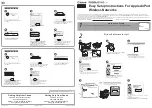
Handleiding Internet van Ziggo
84
the Internet, the stack must also be assigned an IP (Internet Protocol) address.
192.168.100.1 is an example of an IP address. A TCP/IP stack can be configured
to get this IP address by various means, including a DHCP server, by you directly
entering it, or sometimes by a PC generating one of its own.
Ethernet requires that each TCP/IP stack on the Wireless Cable Gateway also
have associated with it an Ethernet MAC (Media Access Control) address. MAC
addresses are permanently fixed into network devices at the time of their
manufacture. 00:90:64:12:B1:91 is an example of a MAC address.
Data packets enter and exit a device through one of its network interfaces. The
gateway offers Ethernet and 802.11b/g/n wireless network interfaces on the
LAN side and the DOCSIS network interface on the WAN side.
When a packet enters a network interface, it is offered to all the TCP/IP stacks
associated with the device side from which it entered. But only one stack can
accept it — a stack whose configured Ethernet address matches the Ethernet
destination address inside the packet. Furthermore, at a packet’s final
destination, its destination IP address must also match the IP address of the
stack.
Each packet that enters a device contains source MAC and IP addresses telling
where it came from, and destination MAC and IP addresses telling where it is
going to. In addition, the packet contains all or part of a message destined for
some application that is running on the destination device. IRC used in an
Internet instant messaging program, HTTP used by a web browser, and FTP
used by a file transfer program are all examples of applications. Inside the
packet, these applications are designated by their port number. Port 80, the
standard HTTP port, is an example of a port number.
The Networking section of the router performs many elegant functions by
recognizing different packet types based upon their contents, such as source
and destination MAC address, IP address, and ports.
5.5
Three Networking Modes
Your gateway can be configured to provide connectivity between your cable
company and your home LAN in any one of three Networking Modes: CM, RG,
and CH. This mode setting is under the control of your cable company, who can
select the mode to match the level of home networking support for which you
have subscribed. All units ship from the factory set for the RG mode, but a
configuration file which the cable company sends the cable modem section
during its initialization can change it.
Содержание Technicolor TC7210
Страница 1: ...Geavanceerde gebruikers handleiding internet Technicolor TC7210...
Страница 2: ......
Страница 7: ...Handleiding Internet van Ziggo 7...
Страница 8: ...Handleiding Internet van Ziggo 8...
Страница 96: ......
Страница 97: ...GEA INT TECHNI 1410 Versie 1 0 Oktober 2014...














































